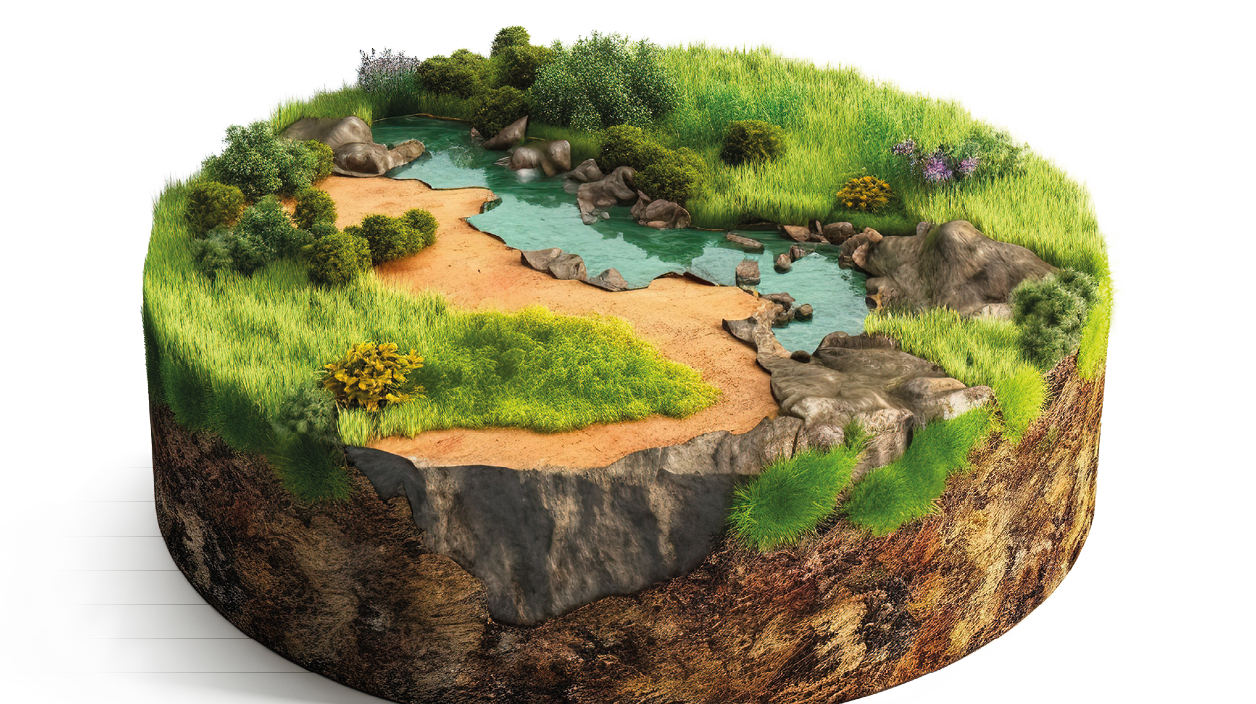
THE SOIL, that unknown that is trampled underfoot...
Article from ❤️
What is it that contains 25% of known biodiversity and 75% of the earth's biomass, builds the world's fertility, regulates the course of rivers and the climate?
Don't look far, just under your feet: it's the soil!
For a long time, it was seen as a support for plants or our constructions, chemically nourishing the plants: in line with this, conventional agriculture uses mineral fertilizers. Little attention was paid to it: considered dirty, perhaps because we put our dead in it, it is opaque and made of invisible components, mineral (like clays) or living (microbes, bacteria and fungi). The current boom in molecular microbiology, which uses DNA to identify species and their metabolism, has been a revolution.
With the advent of high-speed sequencing, thousands of species of fungi, bacteria and amoebae have been discovered in the soil. Beyond the iconic earthworms, a microbial world weighing five to ten tonnes per hectare lives beneath our feet! In fact, geosmin, the substance that gives soil its characteristic odour, is a bacterial product!
This biodiversity keeps the soil alive. Dead organic matter that falls to the ground is decomposed by microbes that feed on it. As they do so, they release carbon (in the form of CO2), nitrogen (in the form of nitrates) and phosphorus (in the form of phosphates), which can once again nourish plants. Pasteur already celebrated the role of microbes: "Without them, life would come to a halt, because the work of death would be incomplete". Microbes also alter rock fragments by dissolving them through local acidification, which accelerates the release of minerals (potassium, phosphorus, iron, etc.), thus making them available to plants. Finally, soil pores store atmospheric gases, notably nitrogen. Nitrogen plays an essential role, as certain bacteria use it to manufacture their proteins. When they die, their contents return to the soil... and are at the origin of all forms of nitrogen present in the soil and in plants, since the rocks on which the soil grows are devoid of it!

Master of the subterranean fate of organic matter, rocks and gases, life in the soil stirs up these components. Complementing the work of earthworms, plant roots and the microscopic filaments of fungi draw resources from deep within the soil, then return them to the surface when the organism dies: their role is vital when soils are devoid of worms, as in North America. What's more, the roots of 90% of all plants join forces with soil fungi in a cooperative arrangement known as mycorrhiza: the fungi assimilate mineral resources far from the root, which they transfer to the plant in exchange for its sugars. The plant is thus in symbiosis with the soil's microbial life.
But the soil also has an effect... outside itself. Firstly, by regulating the water cycle. Unlike bare rock, it retains rainwater, limiting flooding; then it slowly releases it, loaded with minerals, ensuring the fertility of fresh waters and coastlines, which explains why fishing is better there than offshore. Soil nourishes us everywhere, but it also interacts with climate. On the one hand, because it reduces the greenhouse effect by storing carbon from organic matter buried far from the air. On the other hand, because it can also contribute to this effect: when a soil lacks oxygen, bacteria survive with particular respirations that produce methane or nitrogen oxides, which are powerful greenhouse gases... This is what is currently happening to the frozen soils of the Arctic zones, which are melting into a waterlogged soup.
Unfortunately, our practices all too often ignore the living dynamics of the soil. This is particularly true of ploughing. In the short term, it ensures fertility by stirring up minerals, weeding and aerating the soil. But in the process, it kills many living creatures, such as worms and fungal filaments. Aeration facilitates the respiration and decomposition of organic matter, which binds soil components together. In the long term, combined with the destruction of roots, this increases erosion by a factor of ten! The positive effect of ploughing is therefore transitory: after several centuries, all is lost. The poverty of Mediterranean soils, which have nurtured so many great civilizations, bears witness to this. Conversely, no-till practices, such as those used in pre-Columbian America or in conservation agriculture, reduce erosion...
The link between soil and climate is a real issue, as our practices contribute to global warming.
The disappearance of organic matter from agricultural soils, through ploughing and the reduction of manure inputs, reduces carbon storage. Irrigation creates oxygen-free pockets that encourage greenhouse gas emissions, especially after nitrate inputs, which are the precursors of nitrogen oxides. And yet, by burying our organic waste (properly sorted) in the soil, we could store carbon there, while combating erosion. By increasing the carbon content of all the world's soils by 0.4% a year, we could fix the equivalent of the CO2 produced annually by mankind! Soil produces the greenhouse effect when it could reduce it: our ignorance of soil deprives us of a precious tool!
The importance of soil remains largely unknown. Worse still, we cover it up with transport infrastructures and urban sprawl. In France, the surface area is shrinking by the equivalent of a département every decade! And yet, nourishing and protective, soils are impossible to create: they can be moved, but it takes a millennium to generate new fertile soil.
Do we pass on intact soils to future generations, using them as fathers of families? No. The European Union is fighting for this: the "Caring for Soil is Caring for Life" program aims to have 75% of its soil in good condition by 2030. But the target remains elusive. To better preserve this invisible presence that does us good, we urgently need to raise public awareness, limit the extension of our infrastructures and rethink not only our agricultural practices, but also our everyday consumption.

Marc-André SELOSSE
Professor at the Muséum national d'Histoire naturelle, Marc-André Selosse teaches at several universities in France and abroad.
His research focuses on mutual benefit associations (symbioses) involving fungi, and his teaching on microbes, ecology and evolution. Editor of international scientific journals and of Espèces, a popular science magazine, he is also the author of several books published by Actes Sud.
























